Abstract
BACKGROUND: Although maternal employment is considered a risk factor for low birthweight (LBW), the manner in which employment might affect birthweight is poorly understood. In this analysis, selected characteristics of employment during pregnancy were examined for effects on pregnancy outcomes. METHODS: Work characteristics included the number of hours per week, physical activities, and environmental conditions. The outcomes of interest were fetal growth retardation (less than 2500 grams at term) and preterm delivery (less than 37 weeks). The study population consisted of 2711 non-Black, married mothers who participated in the 1980 National Natality Survey (NNS). The NNS data were merged with data from the 1977 revision of The Dictionary of Occupational Titles (DOT) from which measures of occupational physical activities and environmental exposures were obtained. Logistic regression was used in the analysis. RESULTS: Those who worked 40 or more hours per week were more likely than women who worked fewer hours to have a low birthweight delivery at greater than or equal to 37 weeks. No physical or environmental characterics of work were associated with low birthweight or preterm delivery. CONCLUSIONS: Non-Black married American women may face a risk of delivering low-birthweight babies at or near term only if they work 40 or more hours each week. However, the lack of risk associated with other characteristics of work may be a function of measurement error in the DOT data source or of low levels of exposure in the analysis population.
Full text
PDF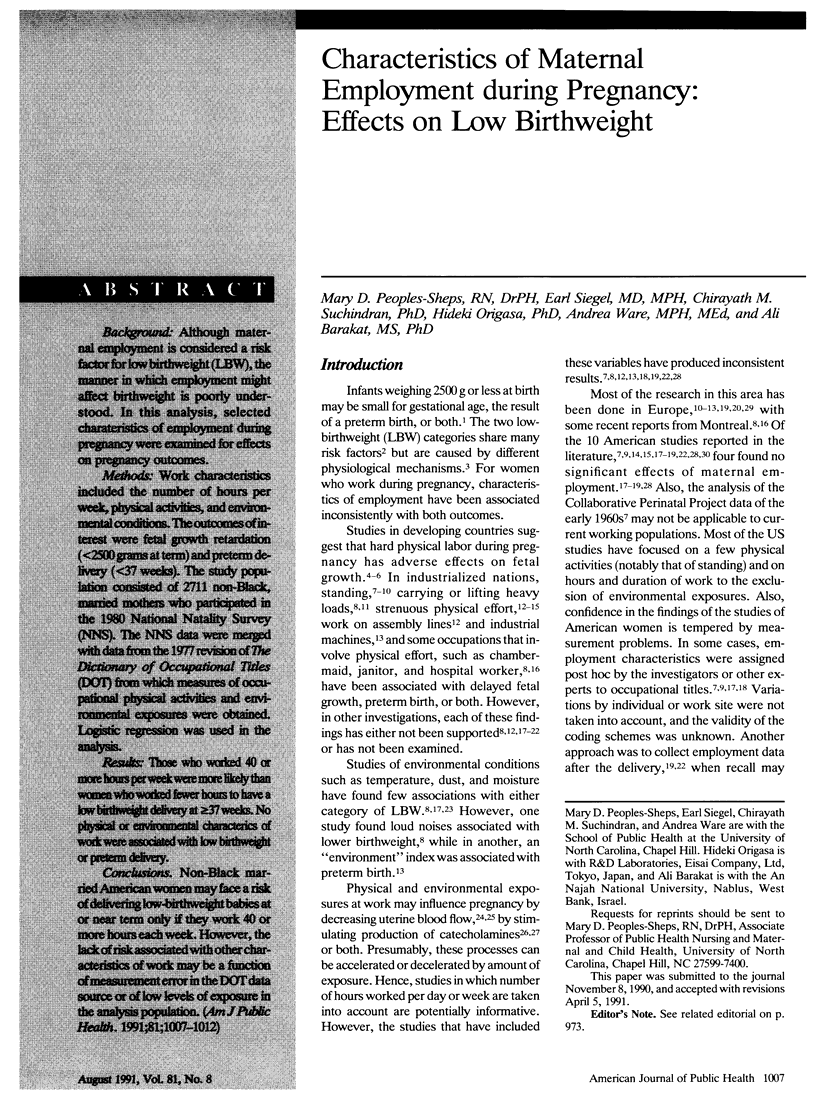
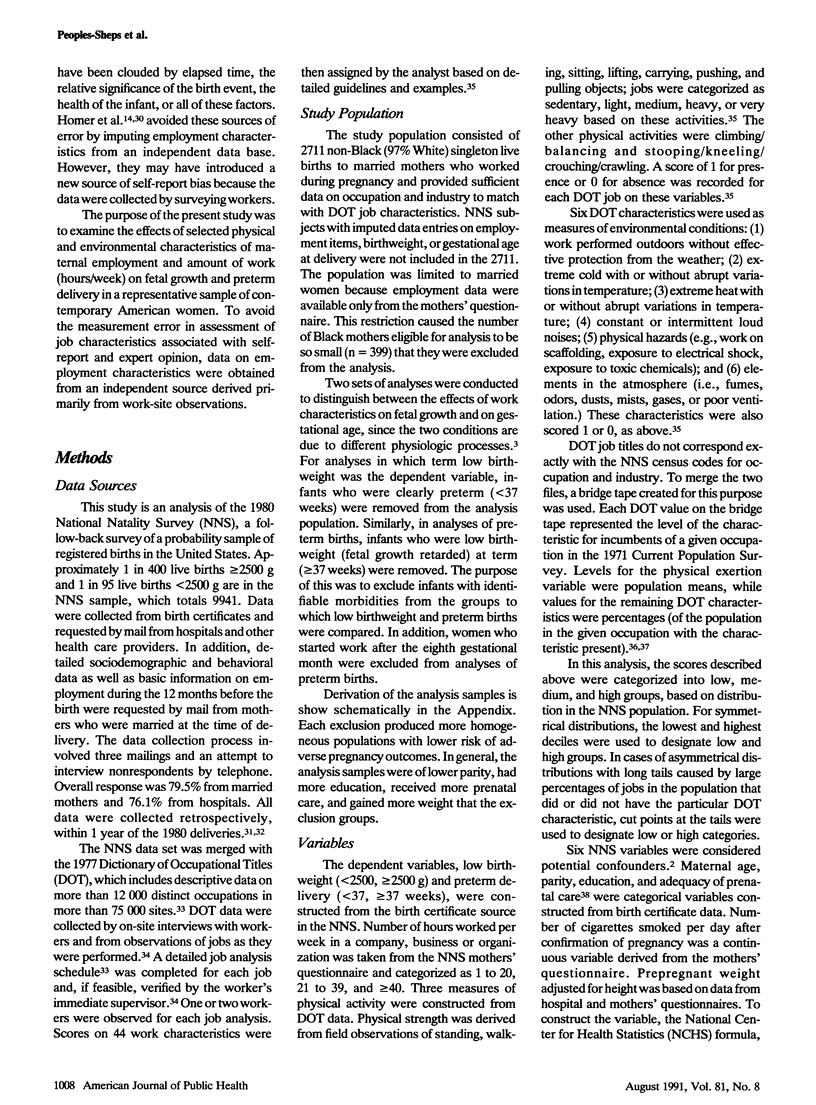
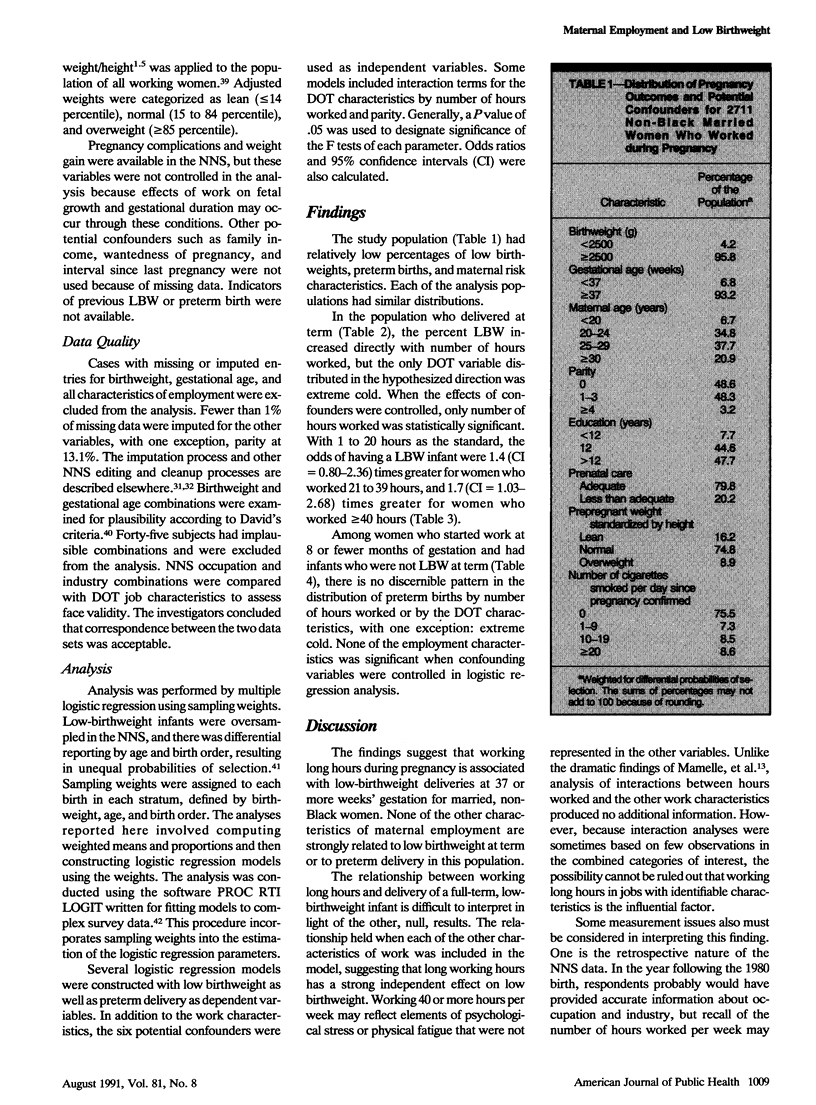

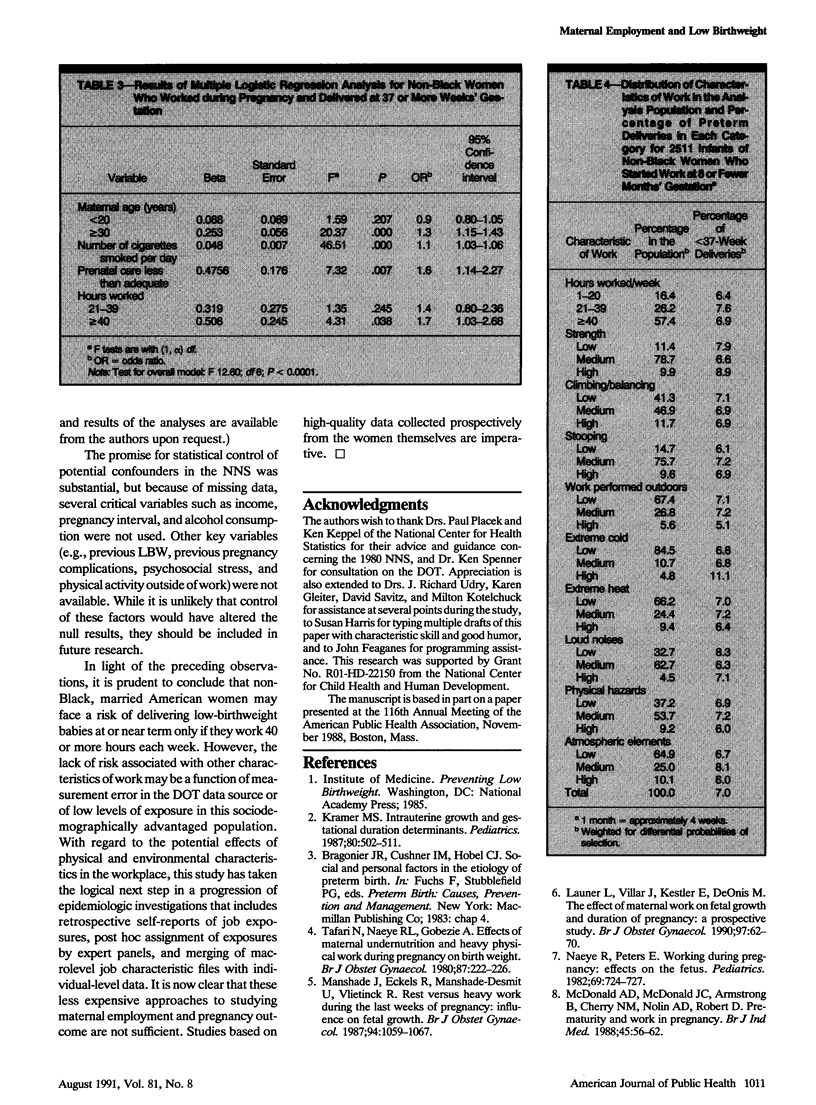
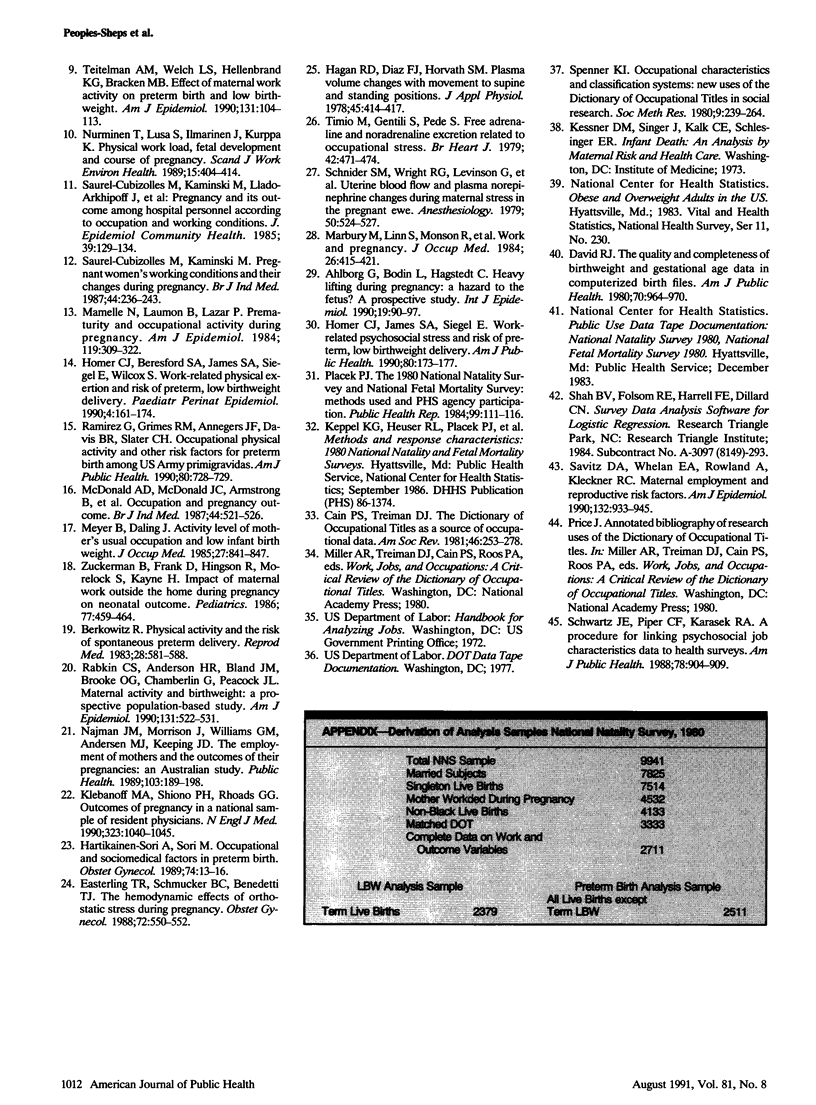
Selected References
These references are in PubMed. This may not be the complete list of references from this article.
- Ahlborg G., Jr, Bodin L., Hogstedt C. Heavy lifting during pregnancy--a hazard to the fetus? A prospective study. Int J Epidemiol. 1990 Mar;19(1):90–97. doi: 10.1093/ije/19.1.90. [DOI] [PubMed] [Google Scholar]
- Berkowitz G. S., Kelsey J. L., Holford T. R., Berkowitz R. L. Physical activity and the risk of spontaneous preterm delivery. J Reprod Med. 1983 Sep;28(9):581–588. [PubMed] [Google Scholar]
- David R. J. The quality and completeness of birthweight and gestational age data in computerized birth files. Am J Public Health. 1980 Sep;70(9):964–973. doi: 10.2105/ajph.70.9.964. [DOI] [PMC free article] [PubMed] [Google Scholar]
- Easterling T. R., Schmucker B. C., Benedetti T. J. The hemodynamic effects of orthostatic stress during pregnancy. Obstet Gynecol. 1988 Oct;72(4):550–552. [PubMed] [Google Scholar]
- Hagan R. D., Diaz F. J., Horvath S. M. Plasma volume changes with movement to supine and standing positions. J Appl Physiol Respir Environ Exerc Physiol. 1978 Sep;45(3):414–417. doi: 10.1152/jappl.1978.45.3.414. [DOI] [PubMed] [Google Scholar]
- Hartikainen-Sorri A. L., Sorri M. Occupational and socio-medical factors in preterm birth. Obstet Gynecol. 1989 Jul;74(1):13–16. [PubMed] [Google Scholar]
- Homer C. J., Beresford S. A., James S. A., Siegel E., Wilcox S. Work-related physical exertion and risk of preterm, low birthweight delivery. Paediatr Perinat Epidemiol. 1990 Apr;4(2):161–174. doi: 10.1111/j.1365-3016.1990.tb00634.x. [DOI] [PubMed] [Google Scholar]
- Homer C. J., James S. A., Siegel E. Work-related psychosocial stress and risk of preterm, low birthweight delivery. Am J Public Health. 1990 Feb;80(2):173–177. doi: 10.2105/ajph.80.2.173. [DOI] [PMC free article] [PubMed] [Google Scholar]
- Klebanoff M. A., Shiono P. H., Rhoads G. G. Outcomes of pregnancy in a national sample of resident physicians. N Engl J Med. 1990 Oct 11;323(15):1040–1045. doi: 10.1056/NEJM199010113231506. [DOI] [PubMed] [Google Scholar]
- Kramer M. S. Intrauterine growth and gestational duration determinants. Pediatrics. 1987 Oct;80(4):502–511. [PubMed] [Google Scholar]
- Mamelle N., Laumon B., Lazar P. Prematurity and occupational activity during pregnancy. Am J Epidemiol. 1984 Mar;119(3):309–322. doi: 10.1093/oxfordjournals.aje.a113750. [DOI] [PubMed] [Google Scholar]
- Manshande J. P., Eeckels R., Manshande-Desmet V., Vlietinck R. Rest versus heavy work during the last weeks of pregnancy: influence on fetal growth. Br J Obstet Gynaecol. 1987 Nov;94(11):1059–1067. doi: 10.1111/j.1471-0528.1987.tb02290.x. [DOI] [PubMed] [Google Scholar]
- Marbury M. C., Linn S., Monson R. R., Wegman D. H., Schoenbaum S. C., Stubblefield P. G., Ryan K. J. Work and pregnancy. J Occup Med. 1984 Jun;26(6):415–421. doi: 10.1097/00043764-198406000-00013. [DOI] [PubMed] [Google Scholar]
- McDonald A. D., McDonald J. C., Armstrong B., Cherry N., Delorme C., D-Nolin A., Robert D. Occupation and pregnancy outcome. Br J Ind Med. 1987 Aug;44(8):521–526. doi: 10.1136/oem.44.8.521. [DOI] [PMC free article] [PubMed] [Google Scholar]
- Meyer B. A., Daling J. R. Activity level of mother's usual occupation and low infant birth weight. J Occup Med. 1985 Nov;27(11):841–847. doi: 10.1097/00043764-198511000-00019. [DOI] [PubMed] [Google Scholar]
- Najman J. M., Morrison J., Williams G. M., Andersen M. J., Keeping J. D. The employment of mothers and the outcomes of their pregnancies: an Australian study. Public Health. 1989 May;103(3):189–198. doi: 10.1016/s0033-3506(89)80074-5. [DOI] [PubMed] [Google Scholar]
- Nurminen T., Lusa S., Ilmarinen J., Kurppa K. Physical work load, fetal development and course of pregnancy. Scand J Work Environ Health. 1989 Dec;15(6):404–414. doi: 10.5271/sjweh.1832. [DOI] [PubMed] [Google Scholar]
- Placek P. J. The 1980 National Natality Survey and National Fetal Mortality Survey--methods used and PHS agency participation. Public Health Rep. 1984 Mar-Apr;99(2):111–116. [PMC free article] [PubMed] [Google Scholar]
- Rabkin C. S., Anderson H. R., Bland J. M., Brooke O. G., Chamberlain G., Peacock J. L. Maternal activity and birth weight: a prospective, population-based study. Am J Epidemiol. 1990 Mar;131(3):522–531. doi: 10.1093/oxfordjournals.aje.a115527. [DOI] [PubMed] [Google Scholar]
- Ramirez G., Grimes R. M., Annegers J. F., Davis B. R., Slater C. H. Occupational physical activity and other risk factors for preterm birth among US Army primigravidas. Am J Public Health. 1990 Jun;80(6):728–730. doi: 10.2105/ajph.80.6.728. [DOI] [PMC free article] [PubMed] [Google Scholar]
- Saurel-Cubizolles M. J., Kaminski M., Llado-Arkhipoff J., Du Mazaubrun C., Estryn-Behar M., Berthier C., Mouchet M., Kelfa C. Pregnancy and its outcome among hospital personnel according to occupation and working conditions. J Epidemiol Community Health. 1985 Jun;39(2):129–134. doi: 10.1136/jech.39.2.129. [DOI] [PMC free article] [PubMed] [Google Scholar]
- Saurel-Cubizolles M. J., Kaminski M. Pregnant women's working conditions and their changes during pregnancy: a national study in France. Br J Ind Med. 1987 Apr;44(4):236–243. doi: 10.1136/oem.44.4.236. [DOI] [PMC free article] [PubMed] [Google Scholar]
- Savitz D. A., Whelan E. A., Rowland A. S., Kleckner R. C. Maternal employment and reproductive risk factors. Am J Epidemiol. 1990 Nov;132(5):933–945. doi: 10.1093/oxfordjournals.aje.a115736. [DOI] [PubMed] [Google Scholar]
- Schwartz J. E., Pieper C. F., Karasek R. A. A procedure for linking psychosocial job characteristics data to health surveys. Am J Public Health. 1988 Aug;78(8):904–909. doi: 10.2105/ajph.78.8.904. [DOI] [PMC free article] [PubMed] [Google Scholar]
- Shnider S. M., Wright R. G., Levinson G., Roizen M. F., Wallis K. L., Rolbin S. H., Craft J. B. Uterine blood flow and plasma norepinephrine changes during maternal stress in the pregnant ewe. Anesthesiology. 1979 Jun;50(6):524–527. doi: 10.1097/00000542-197906000-00010. [DOI] [PubMed] [Google Scholar]
- Tafari N., Naeye R. L., Gobezie A. Effects of maternal undernutrition and heavy physical work during pregnancy on birth weight. Br J Obstet Gynaecol. 1980 Mar;87(3):222–226. doi: 10.1111/j.1471-0528.1980.tb04523.x. [DOI] [PubMed] [Google Scholar]
- Teitelman A. M., Welch L. S., Hellenbrand K. G., Bracken M. B. Effect of maternal work activity on preterm birth and low birth weight. Am J Epidemiol. 1990 Jan;131(1):104–113. doi: 10.1093/oxfordjournals.aje.a115463. [DOI] [PubMed] [Google Scholar]
- Timio M., Gentili S., Pede S. Free adrenaline and noradrenaline excretion related to occupational stress. Br Heart J. 1979 Oct;42(4):471–474. doi: 10.1136/hrt.42.4.471. [DOI] [PMC free article] [PubMed] [Google Scholar]
- Zuckerman B. S., Frank D. A., Hingson R., Morelock S., Kayne H. L. Impact of maternal work outside the home during pregnancy on neonatal outcome. Pediatrics. 1986 Apr;77(4):459–464. [PubMed] [Google Scholar]


